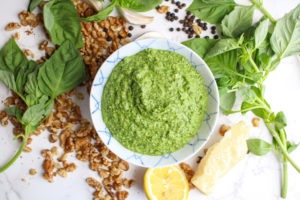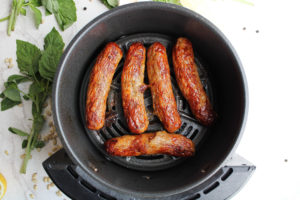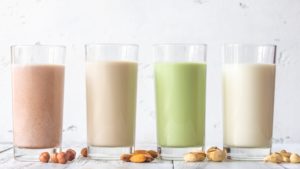Measuring out ingredients while you cook and bake is an underrated skill in the kitchen. There is a lot of science and exactness that goes into cooking. That’s why it’s so important to measure ingredients from recipes as closely as you can. If you don’t, you might get food that has a slightly different taste and texture every time you cook it. Sometimes it’s hard to make accurate conversions, and you might not know where to start. That’s why I want to show you how to convert 600 mL to oz. Knowing 600 ml to ounces will equip you to make other ml to oz conversions.
In this cooking guide, I’ll show you how to convert 600 mL to oz, and other helpful tips, rules, and formulas to help you convert many different measurements.
600 mL = 20.29 fl. Oz.
Table of Contents
- 600 mL = 20.29 fl. Oz.
- What is an Ounce and How to Calculate It?
- What is a Milliliter and How to Calculate It?
- Can You Convert mL to Oz?
- How to Calculate Oz from 600 mL?
- What Fl. Oz. To Use?
- Milliliter and Ounce Abbreviations
- Converting mL to oz in Baking and Cooking
- Is There a Difference Between a Liquid mL and a Dry mL?
- Is There a Difference Between a Liquid Oz and Dry Oz?
- Tips for Precise Pouring and Measuring
- How Many Fluid Ounces Convert into 600 mL?
- Frequently-Asked Questions
- 600 mL to Oz Conversion Chart
- Other Cooking Guides You Might Like
- 600 mL to Oz – Bottomline
What is an Ounce and How to Calculate It?
An ounce is a small unit of measurement. Many types of ounces measure several different units, such as mass, weight, or volume.
For this article, we’re mostly concerned with fluid ounces, or ounces that measure volume or liquid. The three most common types of fluid ounces are the U.S. Customary fluid ounce, ounces for the U.S. food label, and the Imperial fluid ounce. Continue reading to learn more about these types of fluid ounces.
You can calculate ounces in a variety of ways. The easiest way to measure ounces is using a food scale. Many food scales are built to measure the number of ounces of food you weigh. Just make sure your scale label reads “fl. oz.”.
Another way to calculate ounces is to convert the volume of something into ounces from a unit of measure you already know. Let’s use the topic of this article as an example. If you know you have 600 mL, then use a common divider to calculate the equivalent in ounces.
If you convert to U.S. fluid ounces, divide 600 mL by 29.573. You’ll get 20.29 fluid ounces. 29.573 is the conversion factor and is a constant you use every time you convert mL to oz.
What is a Milliliter and How to Calculate It?
A milliliter (mL) is 1/1,000th of one liter. When you have 1,000 milliliters, you have one liter. A liter is the volume of one kilogram of water, equal to 1,000 cubic centimeters, 61 cubic inches, 0.001 cubic meters, 0.0013 cubic yards, or 1.75 pints.
You can calculate milliliters in a similar way as ounces. First, food scales can measure milliliters, and it’s one of the easiest ways to measure mL.
However, if you don’t have a food scale, then you can manually calculate mL by converting a volume you have from another unit of measure.
For example, if you have 100 oz of liquid, how many mL is that? Multiply 100 oz by 29.573. 29.573 is the conversion factor that will always remain constant no matter how many ounces you’re converting.
| Ounce Quantity | Formula | Total mL |
|---|---|---|
| 100 ounces | 100 x 29.573 | 2,957 mL |
| 50 ounces | 50 x 29.573 | 1,479 mL |
| 10 ounces | 10 x 29.573 | 296 mL |
| 1 ounce | 1 x 29.573 | 29.6 mL |
Can You Convert mL to Oz?
Yes, you can! You can do a simple calculation, and convert in less than a minute!
Divide the number of mL by the conversion factor, 29.573. That will convert your mL to oz.
To convert 600 mL, divide 600 by 29.573. You’ll get 20.29 fluid ounces.
How to Calculate Oz from 600 mL?
You can calculate ounces by dividing the number of mL you want to convert, by the conversion factor of ounces. Keep in mind that there are different types of ounces, including fluid ounces (that measure liquid), that have different conversion factors.
U.S. Customary Fluid Ounce (US Fl Oz)
A U.S. customary fluid ounce is 1/16th of a U.S. liquid pint, and 1/128th of a U.S. liquid gallon, or exactly 29.5735295625 mL. The U.S. fl. Oz. is about 4% larger than the imperial ounce.
To calculate 600 mL to oz using U.S. customary fluid ounce, divide 600 mL by the conversion factor of 29.5735295625. You’ll get 20.29 U.S. customary fluid ounces.
600 mL ÷ 29.5735295625 mL = 20.29 fl. Oz.
U.S. Food Label
Food labels in the U.S. can often label how many milliliters are in something. What if you’re reading a food label with mL, and you want to know how many fluid ounces it is? Maybe you’re writing your own food label.
The conversion factor is 30. Every fluid ounce is equal to 30 mL. Here is the calculation:
600 mL ÷ 30 mL = 20.00 fl. Oz.
Imperial Fluid Ounce (UK Fl Oz)
The Imperial fluid ounce is used in Europe. One imperial fluid ounce is equal to 28.4130625 mL. Divide 600 mL by 28.4130625 mL. You’ll get 21.12 fl. Oz.
600 mL ÷ 28.4130625 mL = 21.12 fl. Oz.
What Fl. Oz. To Use?
First, ask yourself, what type of fluid ounce do you want to convert? This will largely depend on what you’re using your conversion for.
If you’re living in the United States, making a European recipe that calls for 600 mL, then you’ll want to use U.S. fluid ounces. If you are calculating the amount of fluid ounces for a food label, then use the conversion factor for the U.S. food label.
It’s important to assess your goals and the reason you need to convert these numbers in the first place, before deciding what type of fluid ounce to use.
Milliliter and Ounce Abbreviations
It’s easier to work with these measurements when you can abbreviate the unit label quickly. If you’re cooking and you have to quickly calculate and write down how many mL is in ounces, you don’t want to write out the long words of milliliter and ounces.
Here are the abbreviations:
- Milliliter = mL
- Ounces = Oz.
- U.S. Customary Fluid Ounces = U.S. Fl. Oz.
- Imperial Fluid Ounce = UK Fl. Oz.
Converting mL to oz in Baking and Cooking
mL is a measure of volume. When you’re baking, a recipe might ask you for mL of liquid to add to a recipe, such as water, milk, or cream. When a recipe asks for mL in liquid, and you’re trying to convert it to ounces, make sure they are fluid ounces and not regular ounces.
Fluid ounces will measure differently than regular ounces. That’s because fluid ounces measure volume and regular ounces measure weight. Here’s the difference between weight and volume.
Volume: This is the measurement of how much space something takes up. For example, a cup of flour or 600 mL of water. A cup of water will be the same as a cup of flour.
Weight: This is the measurement of how heavy something is. For example, grams of sugar or pounds of flour. If you weighed the heaviness of the same volume of water and flour, they would weigh differently! The flour is less dense than water.
Whenever you’re converting mL to oz, use a measuring cup that measures volume.
Is There a Difference Between a Liquid mL and a Dry mL?
While a milliliter remains the same volume whether measuring liquid or dry ingredients, the weight can vary due to the density of the substance. For instance, 1 mL of water has the same weight as 1 gram, whereas 1 mL of flour might weigh less due to its lower density.
Is There a Difference Between a Liquid Oz and Dry Oz?
Similarly, the ounce remains almost the same whether measuring liquid or dry ingredients in terms of volume, but the weight can differ. For example, if you measure ounces in flour and water, you may have the same volume of flour, but a different weight, since flour is less dense than water. Keep in mind that fluid ounces (US fl oz) for liquids and dry ounces might have slight variations due to density.
Also, remember that different fluid-ounce units of measure will yield slightly different results. If you’re converting 600 milliliters to U.S. customary fluid ounces, food label ounces, and imperial fluid ounces, all your ounces will slightly vary. See below:
| Qty. | U.S. Customary Fluid Ounces | U.S. Food Label Ounces | Imperial Fluid Ounces |
|---|---|---|---|
| 600 mL | 20.29 fl. oz. | 20.00 fl. oz. | 21.12 fl oz. |
Do the differences in fluid ounces matter in cooking and baking? Yes, they do! It’s important to be as exact as possible while cooking especially baking, so you can yield consistent (and flavorful) results from your recipes every time.
See below for tips on ensuring accuracy while cooking and baking with measurements.
Tips for Precise Pouring and Measuring
- Choose the Right Tools: Just like a painter selects the finest brushes, you should choose the right measuring tools for the job. Utilize graduated measuring cups designed specifically for liquids and dry ingredient measuring cups for powders, flours, and other dry substances. This difference ensures accurate measurements, as each type of cup is calibrated to provide precise volumes for its intended contents.
- Convert with Care: Ensure you convert accurately in recipes that use metric and imperial measurements. Use a reliable conversion chart or calculator to maintain the proper ratios, preserving the integrity of your culinary masterpiece. I recommend you bookmark this article and sign up for my newsletter so you can follow when new conversion articles come out.
- Use a Unit Converter: You can use a measurement converter, whether that’s googling one online, using an app on your phone, or food scale. Using a converter can be a quick and simple way to convert a variety of different measurements without having to know the math behind it. They can be useful to convert for tablespoons, teaspoons, U.S. and Imperial pints, quarts, U.S. and Imperial gallons, inches, meters, cups, and more.
- Mind Your Eye Level: When measuring liquids in graduated measuring cups, always check the volume at eye level. This eliminates parallax errors, which can occur if you read the measurement from an angle. Accurate readings prevent over-pouring or under-pouring, leading to consistent and balanced flavors in your dishes.
- Be Mindful of Density: Keep in mind that different ingredients have varying densities. A cup of chopped vegetables will have a different weight than a cup of grated cheese. Be sure to adjust your measuring technique based on the ingredients to maintain precision.
- Practice Patience: Rushing through measuring can lead to inaccuracies. Take your time and measure with care, especially for critical components like leavening agents or spices that can impact the final taste and texture of your dish.
- Taste and Adjust: Remember, precision is your ally, but don’t forget the essence of cooking – your palate. Taste as you go and make adjustments to seasoning and flavors as needed. The numbers guide you, but your intuition and creativity bring your dishes to life.
How Many Fluid Ounces Convert into 600 mL?
Follow the conversion for U.S. Customary Fluid Ounces. Divide 600 mL by 29.5735295625.
600 mL ÷ 29.5735295625 = 20.29 fl. Oz.
Frequently-Asked Questions
In one mL, there is 0.0338 U.S. fluid ounces. To calculate this, you divide 1 by 29.573. To calculate any number of ounces into mL, just divide the number of ounces by 29.573. Below is a quick conversion chart.
1 mL: 1 ÷ 29.573 = 0.0338 fl. oz.
2 mL: 2 ÷ 29.573 = 0.068 fl. oz.
3 mL: 3 ÷ 29.573 = 0.101 fl. oz.
5 mL: 5 ÷ 29.573 = 0.169 fl. oz.
10 mL: 10 ÷ 29.573 = 0.338 fl. oz.
20 mL: 20 ÷ 29.573 = 0.676 fl. oz.
50 mL: 50 ÷ 29.573 = 1.691 fl. oz.
600 mL is 20.29 fl. oz.
20.29 fluid ounces. By measuring in liquid, it doesn’t change the conversion.
600 mL is 20.29 fluid ounces in water. Just like the previous question, measuring water vs. other types of liquids does not change the number of ounces when you convert from mL.
600 mL equals 2.54 U.S. cups. To calculate this, divide the volume in mL by the cup size. If you want to measure one cup of water, that is 237 mL.
600 mL to Oz Conversion Chart
Below, is a chart listing the most commonly-asked mL conversions, and what they convert into for U.S. fl. Oz, food label oz, and Imperial fl. Oz.
| Qty. | U.S. Customary Fluid Ounces | U.S. Food Label Ounces | Imperial Fluid Ounces |
|---|---|---|---|
| 600 mL | 20.29 fl. oz. | 20.00 fl. oz. | 21.12 fl. oz. |
| 500 mL | 16.91 fl. oz. | 16.67 fl. oz. | 17.60 fl. oz. |
| 400 mL | 13.53 fl. oz. | 13.33 fl. oz. | 14.08 fl. oz. |
| 300 mL | 10.14 fl. oz. | 10 fl. oz. | 10.56 fl. oz. |
| 200 mL | 6.76 fl. oz. | 6.67 fl. oz. | 7.04 fl. oz. |
| 180 mL | 6.09 fl. oz. | 6 fl. oz. | 6.34 fl. oz. |
| 150 mL | 5.07 fl. oz. | 5 fl. oz. | 5.28 fl. oz. |
| 100 mL | 3.38 fl. oz. | 3.33 fl. oz. | 3.52 fl. oz. |
| 50 mL | 1.69 fl. oz. | 1.67 fl. oz. | 1.76 fl. oz. |
| 20 mL | 0.68 fl. oz. | 0.67 fl. oz. | 0.70 fl. oz. |
Bookmark this page so you can reference this table for later!
Other Cooking Guides You Might Like
- 7 Non-Dairy Substitutes for Buttermilk
- How to Roast Garlic in the Oven
- How to Make Oat Flour in Less Than 5 Minutes!
- How Many Ounces is 187 mL?
- Air Fryer Italian Sausage
- Broccoli Rabe Substitutions
600 mL to Oz – Bottomline
600 mL is 20.29 fluid ounces. Every time you want to convert any amount of milliliters into ounces, use the conversion factor of 29.5735295625 and divide it by the number of mL you want to convert. It’s that simple.
Converting measurements doesn’t have to be hard. Once you know the basic concepts of conversion, you can be well on your way to converting with ease.
If you found this article helpful, subscribe to my newsletter, to receive more conversion and measurement tips straight to your inbox.











